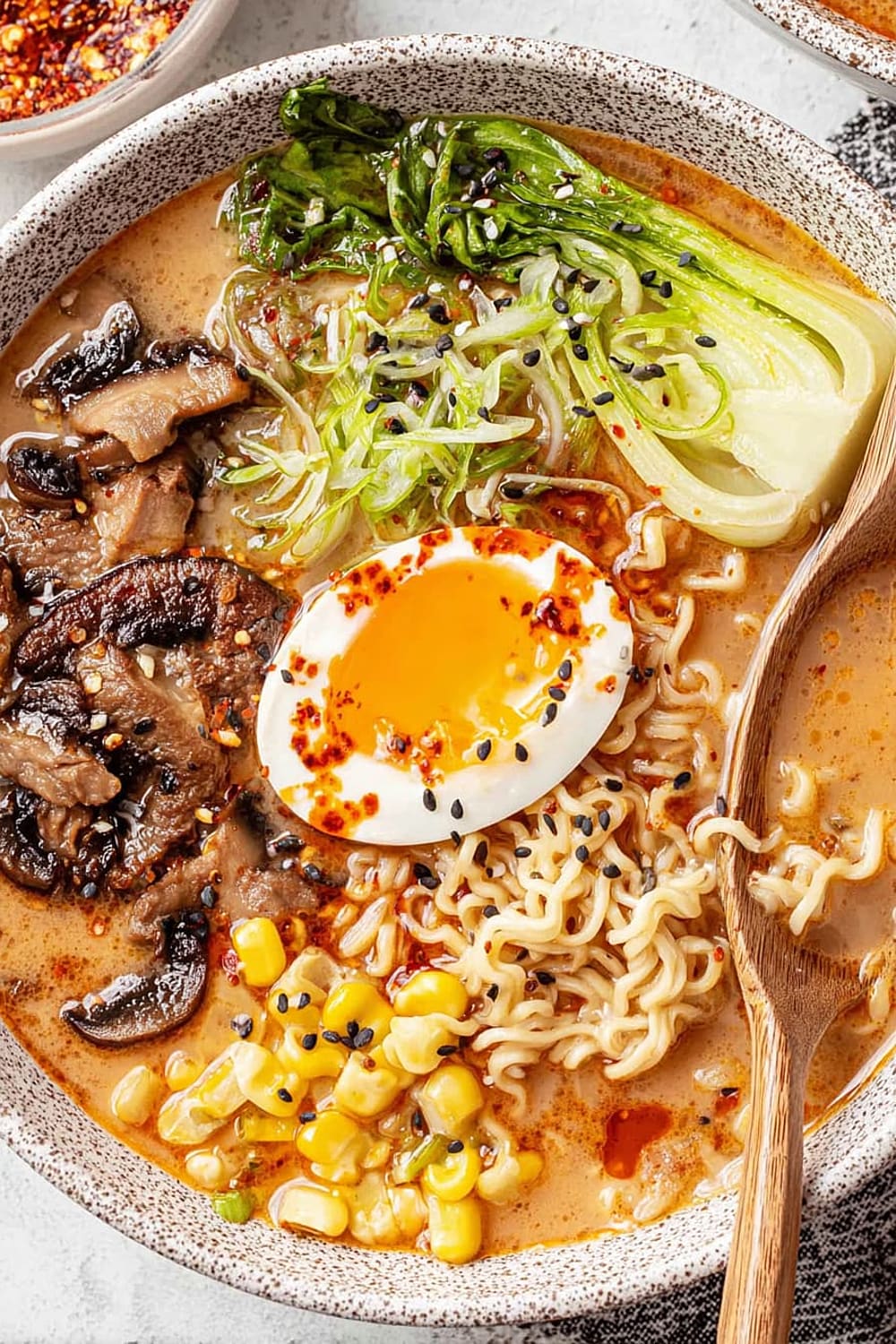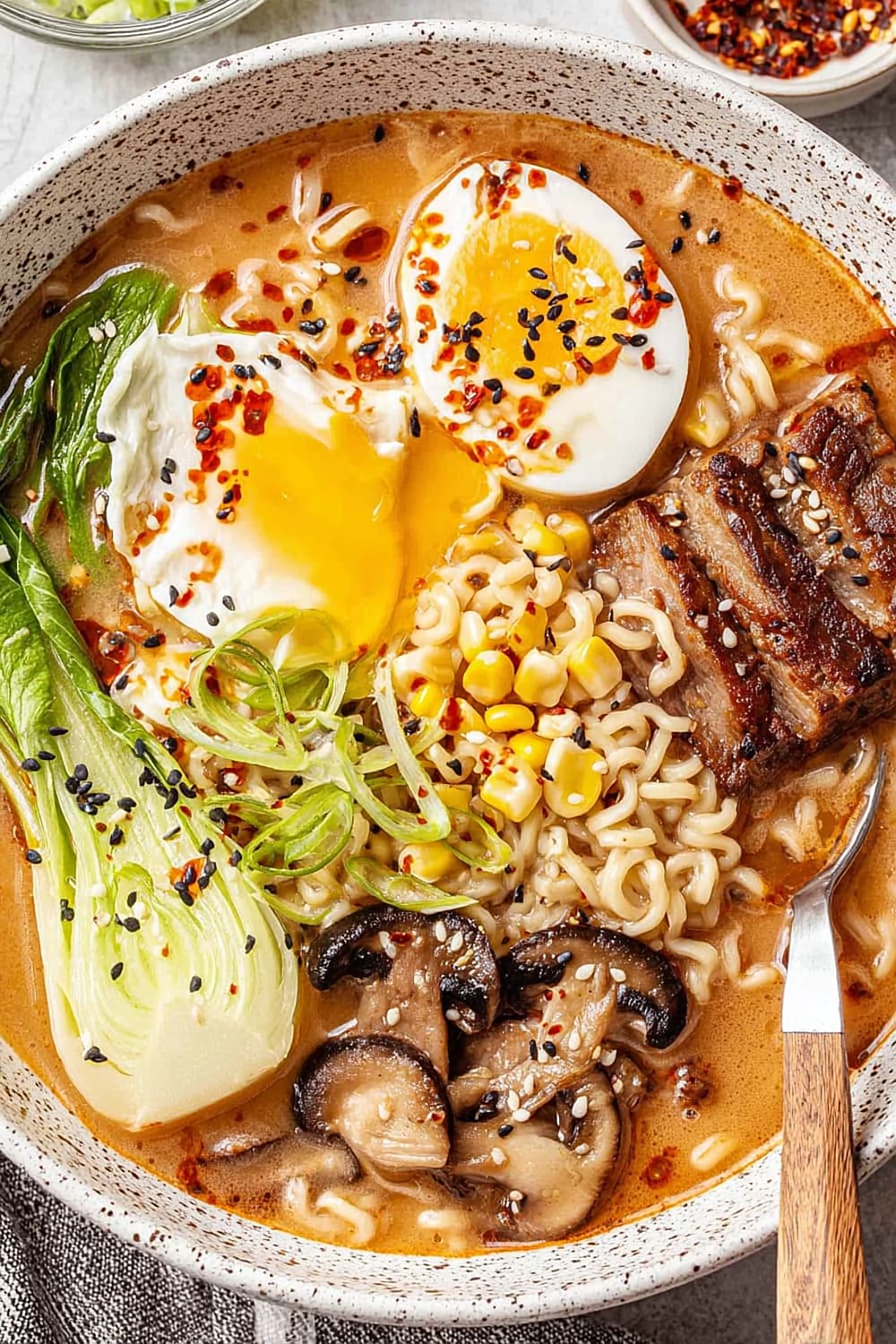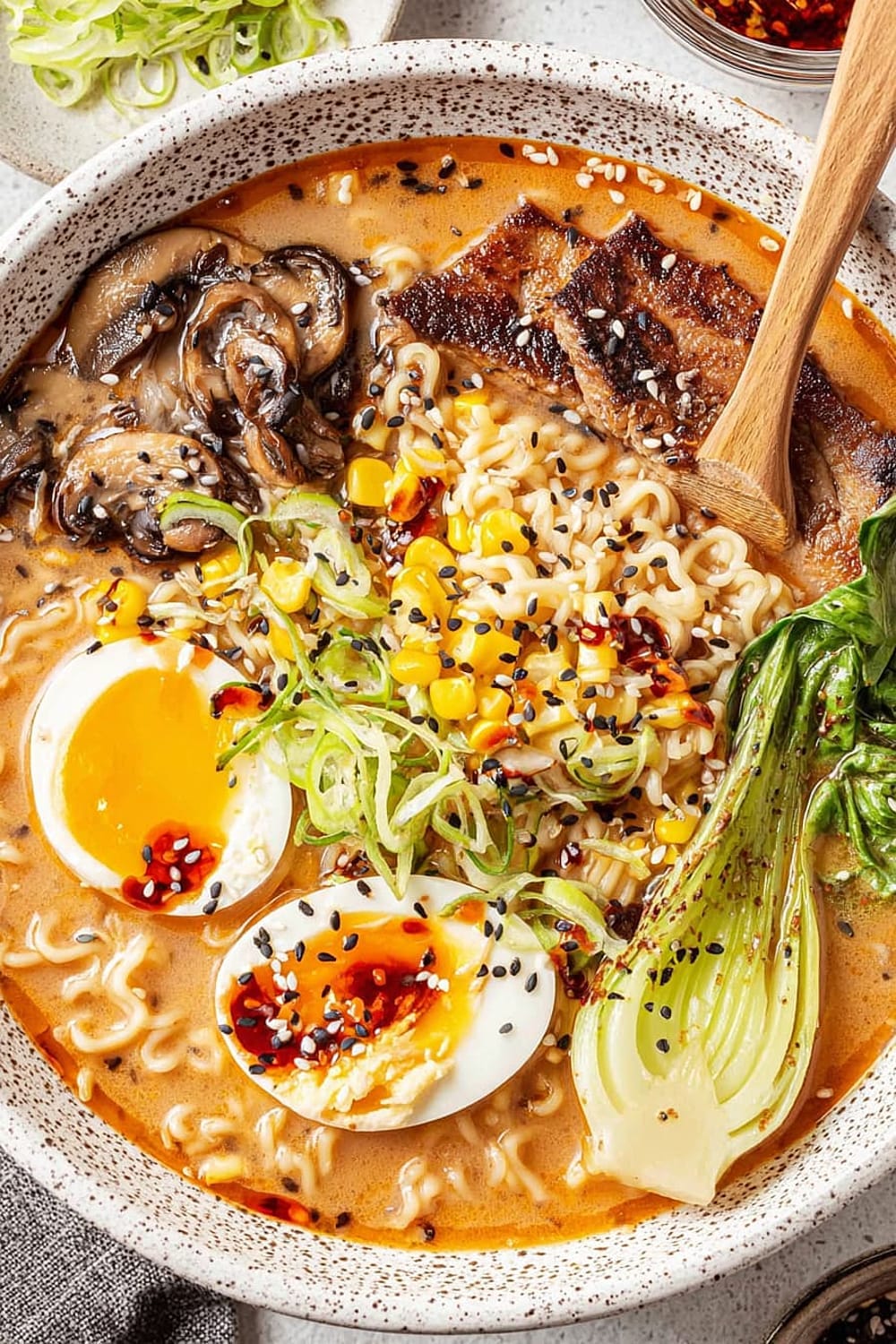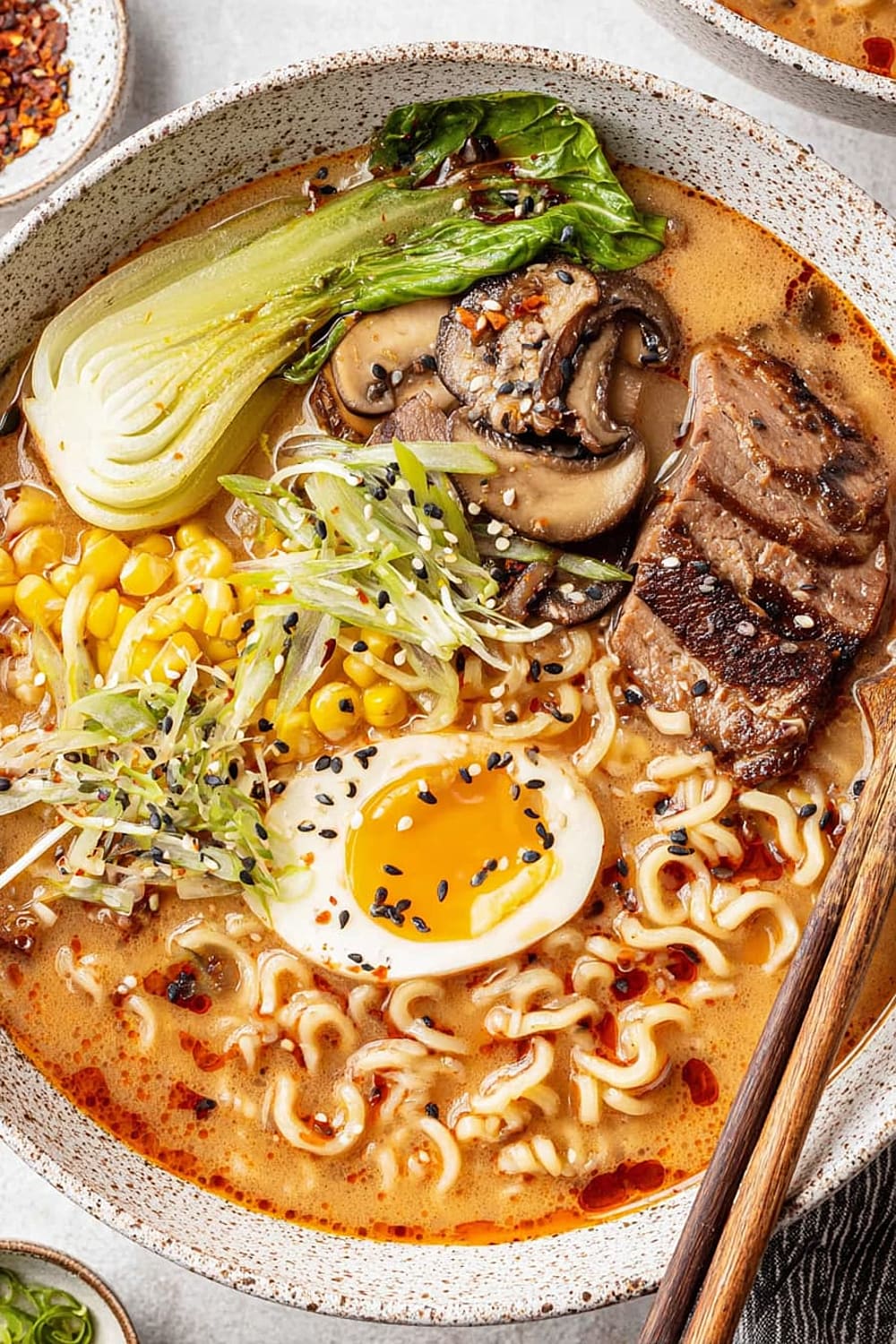Easy Miso Pork Ramen

This miso pork ramen is basically your ticket to becoming the neighborhood’s unofficial ramen master without having to spend years perfecting your technique or breaking the bank at fancy Japanese restaurants.

The rich, umami-packed broth combines creamy miso paste with nutty tahini, creating a depth of flavor that’ll have you questioning why you ever settled for those basic instant noodle packets.

What makes this recipe absolutely brilliant is how it transforms simple ground pork into crispy, golden nuggets that add incredible texture contrast to every spoonful.

The shiitake mushrooms bring an earthy richness that pairs perfectly with the savory broth, while fresh corn kernels and baby bok choy add pops of sweetness and crunch.

This is the kind of recipe that makes you feel like a culinary genius, even though it only takes 25 minutes from start to finish and uses ingredients you can find at any regular grocery store.

Prepare yourself for the ultimate compliment when someone asks if you ordered this from that expensive ramen place downtown – nope, you just followed directions and trusted the process.

Ingredients
For the Miso Pork Ramen
- 2 tablespoons olive oil
- 8-10 ounces shiitake mushrooms, stems removed, thinly sliced
- 1 medium shallot, minced
- 4 teaspoons garlic paste (Gourmet Garden recommended)
- 2 teaspoons ginger paste (Gourmet Garden recommended)
- 1 lb ground pork
- 1 /4 cup white miso paste
- 3 tablespoons tahini
- 1 tablespoon sesame oil
- 2 tablespoons low-sodium soy sauce or coconut aminos
- 2 tablespoons mirin or rice vinegar
- 4-6 cups low-sodium chicken or vegetable broth
- 1 /4 teaspoon white pepper
- 2 packages instant ramen (discard seasoning packets)
For the Toppings
- 1 cup sweet corn kernels (fresh from 2 ears or frozen)
- 2 baby bok choy
- Chili crunch or chili oil
- Crispy mushrooms (reserved from cooking)
- Soy sauce eggs or soft-boiled eggs, halved
- Thinly sliced green onions or sesame seeds
- Ramen eggs or soft-boiled eggs

Instructions
Prepare the Aromatics and Mushrooms
- 1 Heat 1 tablespoon olive oil in a large Dutch oven or heavy-bottomed pot over medium-high heat until shimmering. The oil should move freely around the pan when you tilt it, indicating it’s properly heated and ready for the mushrooms.
- 2 Add the sliced shiitake mushrooms and cook for 2-3 minutes without stirring initially, allowing them to develop a golden-brown crust. You’ll hear them sizzle aggressively at first, then the sound will quiet as moisture evaporates. Remove 1/2 cup of the crispiest mushrooms and set aside for garnish.
- 3 Add the remaining tablespoon of olive oil to the pot and immediately add the minced shallot, garlic paste, and ginger paste. Cook until fragrant and softened, about 2-3 minutes, stirring frequently to prevent burning. The mixture should smell aromatic and the shallots should become translucent.
Cook the Pork
- 4 Add the ground pork to the pot with the mushroom and aromatics mixture. Break it up with a wooden spoon or spatula, cooking until no pink remains, about 5-6 minutes. Let the pork sit undisturbed for 30-60 seconds at a time to develop crispy, golden edges before stirring and repeating the process.
Build the Broth
- 5 Add the miso paste, tahini, sesame oil, soy sauce, mirin, and white pepper to the pot. Stir vigorously to combine, breaking up any clumps of miso paste against the sides of the pot. The mixture will look thick and paste-like initially.
- 6 Gradually add 4 cups of broth, stirring constantly to incorporate the miso mixture smoothly. Bring to a gentle boil over medium-high heat, then reduce to low heat and simmer for 8-10 minutes. The broth should develop a rich, creamy appearance and the flavors should meld together beautifully.
Finish the Ramen
- 7 While the broth simmers, prepare the instant ramen noodles according to package directions, discarding the seasoning packets. Drain thoroughly and set aside. Fresh ramen noodles should be slightly firm to the bite, not mushy.
- 8 During the last 2-3 minutes of broth simmering, add the corn kernels and bok choy directly to the pot. Add up to 2 additional cups of broth if you prefer a thinner consistency. Remove from heat once the vegetables are crisp-tender.
- 9 Divide the cooked noodles between 6 serving bowls. Ladle the hot miso pork broth over the noodles, ensuring each bowl gets an equal portion of pork and vegetables. Top with reserved crispy mushrooms, chili oil, soft-boiled eggs, green onions, and sesame seeds as desired. Serve immediately with chopsticks and soup spoons.

Recommended Equipment and Kitchen Tools
Essential Tools (for best results):
- Large Dutch oven or heavy-bottomed pot – The thick bottom prevents scorching while building the flavorful base, and the wide surface area allows for proper browning of the pork and mushrooms
- Sharp chef’s knife – Critical for efficiently slicing the shiitake mushrooms to uniform thickness, ensuring even cooking and professional presentation
- Wooden spoon or silicone spatula – Perfect for stirring the miso paste and breaking up ground pork without scratching your cookware
- Fine-mesh strainer – Essential for draining the ramen noodles completely, preventing diluted broth
Helpful Upgrades:
- Immersion blender – If you prefer an ultra-smooth broth, a quick blend can create restaurant-quality consistency without transferring hot liquid
- Digital kitchen scale – Measuring miso paste and tahini by weight ensures consistent results every time, especially important for the umami balance
- Microplane grater – Fresh ginger and garlic create more complex flavors than paste, though the convenience of paste makes this recipe more accessible
Nice-to-Have Options:
- Ramen bowls with wide openings – Traditional ceramic bowls retain heat longer and provide the authentic presentation experience
- Chopstick rests and soup spoons – Complete the authentic dining experience and keep your table clean during the meal

Recipe Variations and Dietary Modifications
Protein Variations:
- Ground chicken or turkey → Substitute 1:1 for pork, but add 1 tablespoon extra olive oil since these leaner meats need additional fat for proper browning
- Plant-based ground meat → Use 1 lb crumbled extra-firm tofu or plant-based ground, adding 1 tablespoon soy sauce for extra umami depth
- Sliced pork belly → Cut 8 oz pork belly into thin strips for a more traditional ramen experience with richer flavor
Broth Modifications:
- Vegetarian version → Replace chicken broth with mushroom or vegetable broth and add 1 tablespoon nutritional yeast for extra savory depth
- Spicy miso ramen → Add 1-2 tablespoons gochujang or sriracha to the miso mixture for Korean-inspired heat
- Rich tonkotsu-style → Replace 1 cup of broth with heavy cream and simmer an additional 5 minutes for ultra-creamy texture
Noodle Alternatives:
- Fresh ramen noodles → Substitute with 12 oz fresh ramen noodles from the refrigerated section, reducing cooking time to 2-3 minutes
- Rice noodles → Use 8 oz wide rice noodles for gluten-free option, following package directions carefully to prevent mushiness
- Shirataki noodles → For low-carb version, use 2 packages shirataki noodles, rinsed thoroughly and pan-fried for 2 minutes to remove excess moisture
Seasonal Vegetable Swaps:
- Winter version → Replace bok choy with sliced napa cabbage and roasted butternut squash cubes
- Spring adaptation → Add snap peas, asparagus spears, and fresh spinach in the final 2 minutes of cooking
- Summer variation → Include zucchini noodles and cherry tomatoes for lighter, garden-fresh flavors

Nutritional Information and Health Benefits
Key Nutritional Highlights:
This miso pork ramen provides approximately 420 calories per serving, with a well-balanced macronutrient profile of 28g protein, 35g carbohydrates, and 18g healthy fats. The ground pork delivers complete protein with all essential amino acids, while the shiitake mushrooms contribute significant amounts of selenium, potassium, and B-vitamins. The miso paste provides beneficial probiotics that support digestive health, along with 12g protein per 1/4 cup serving. The tahini adds healthy monounsaturated fats and provides approximately 4g fiber per serving.
Health Benefits of Main Ingredients:
The white miso paste contains live probiotics that support gut health and immune function, while providing umami flavor without excessive sodium compared to regular salt. Shiitake mushrooms are powerhouses of nutrition, containing lentinan, a beta-glucan that supports immune system function and may help regulate cholesterol levels. The fresh ginger and garlic provide anti-inflammatory compounds and antioxidants, with ginger specifically helping with digestion and nausea reduction. Sesame oil and tahini contribute healthy fats, lignans, and vitamin E, which support heart health and provide antioxidant protection.
Dietary Considerations:
This recipe contains gluten from wheat-based ramen noodles and soy from miso paste and soy sauce. The dish is naturally dairy-free and can easily accommodate various dietary restrictions. Each serving provides approximately 15% of daily fiber needs and 35% of daily protein requirements. The sodium content is moderate at approximately 980mg per serving, primarily from the miso paste and broth, making portion control important for those monitoring sodium intake.

Smart Swaps and Ingredient Substitutions
Miso Paste Alternatives:
- White miso paste → Red miso paste (use 3 tablespoons instead of 1/4 cup as red miso is saltier and more intense)
- Miso paste → 2 tablespoons soy sauce + 1 tablespoon peanut butter + 1 teaspoon rice vinegar for emergency substitution
- White miso → Yellow miso (substitute 1:1 for similar mild flavor profile)
Tahini Substitutions:
- Tahini → Natural peanut butter or almond butter (use 2 tablespoons instead of 3 as nut butters are thicker)
- Tahini → 2 tablespoons sesame seeds ground with 1 tablespoon neutral oil for homemade version
- Tahini → Sunflower seed butter for nut-free option with similar creamy texture
Mushroom Alternatives:
- Shiitake mushrooms → Baby bella or cremini mushrooms (increase cooking time to 4-5 minutes for proper browning)
- Fresh shiitake → 1 oz dried shiitake mushrooms, rehydrated in warm water for 20 minutes and sliced
- Shiitake mushrooms → Oyster mushrooms for similar umami depth but more delicate texture
Budget-Friendly Swaps:
- Ground pork → Ground chicken thighs (more affordable and similar fat content for flavor)
- Fresh ginger/garlic paste → 1 teaspoon ground ginger + 2 teaspoons garlic powder (reduce by half since dried spices are more concentrated)
- Mirin → 1 tablespoon rice vinegar + 1 teaspoon sugar for homemade sweet rice wine substitute
Pantry Emergency Substitutions:
- Sesame oil → 1 tablespoon vegetable oil + 1/2 teaspoon toasted sesame seeds for similar nutty flavor
- Low-sodium broth → Regular broth diluted with equal parts water to control sodium levels
- Baby bok choy → Regular bok choy chopped smaller or napa cabbage for similar crisp texture

Make It Diabetes-Friendly
Carbohydrate Reduction Strategies:
- Replace instant ramen noodles → Shirataki noodles or zucchini noodles to reduce carbs from 35g to 8g per serving
- Reduce noodle portion → Use 1 package ramen instead of 2 packages, supplementing with extra shiitake mushrooms and bok choy for volume
- Add extra protein → Increase ground pork to 1.5 lbs to improve satiety and reduce blood sugar spikes
Smart Ingredient Modifications:
- Eliminate mirin → Replace with rice vinegar only to remove 4g added sugars per serving
- Increase fiber content → Double the bok choy and add 1 cup broccoli florets to slow carbohydrate absorption
- Boost healthy fats → Add 1/2 sliced avocado per bowl to improve satiety and blood sugar stability
Portion Control Tips:
- Serve in smaller bowls with 2/3 cup noodles per person instead of full portions
- Pair with side salad dressed in rice vinegar and sesame oil to increase meal volume without carbs
- Time consumption → Eat this meal 2-3 hours before bedtime to allow proper digestion and blood sugar management
Blood Sugar Management:
- Total carbs reduced from 35g to 18g per serving with noodle substitutions
- Add 10-minute walk after eating to help with glucose uptake
- Monitor portions of corn kernels, limiting to 1/2 cup total rather than 1 cup for the recipe

Perfect Pairing Suggestions
Beverage Pairings:
Japanese beer like Sapporo or Asahi complements the umami-rich broth without overpowering the delicate miso flavors, while the carbonation helps cleanse the palate between rich spoonfuls. Sake served warm enhances the fermented miso notes and creates an authentic Japanese dining experience. For non-alcoholic options, unsweetened green tea or jasmine tea provides a clean, refreshing contrast to the rich, savory broth. Sparkling water with fresh lime cuts through the richness while maintaining the Asian flavor profile.
Side Dish Recommendations:
Cucumber sunomono salad with rice vinegar dressing provides a crisp, acidic contrast that refreshes the palate between bites of rich ramen. Gyoza or pot stickers complement the meal’s Asian flavors while adding textural variety with their crispy bottoms and tender tops. Simple edamame seasoned with sea salt offers plant-based protein and a satisfying pop of freshness. Pickled vegetables like daikon radish or carrots provide probiotics and tangy flavors that enhance digestion of the rich broth.
Complete Meal Ideas:
Start with miso soup with tofu and wakame as a light appetizer that prepares the palate for the main ramen course. Follow the ramen with mochi ice cream or dorayaki for a traditional Japanese dessert that provides a sweet finish without being overly heavy. For entertaining, create a ramen bar with multiple toppings like nori sheets, bamboo shoots, and different chili oils so guests can customize their bowls.
Seasonal Serving Suggestions:
This hearty ramen is perfect for cold weather comfort food, especially during fall and winter months when the warming spices and rich broth provide satisfying nourishment. Serve for casual dinner parties where the interactive nature of customizing toppings creates a fun, social dining experience.

Pro Tips and Troubleshooting
Professional Flavor Enhancement Techniques:
Toast the sesame oil in the pot for 30 seconds before adding other ingredients to intensify its nutty flavor and create deeper complexity in the final broth. Bloom the white pepper in the hot oil alongside the aromatics to release its full aromatic potential rather than adding it raw. Reserve some crispy pork separately from the broth to add as a final garnish, providing textural contrast and preventing all the meat from becoming soft during simmering.
Common Mistakes and Solutions:
Miso paste clumping is the most frequent issue – prevent this by whisking miso with 1/2 cup warm broth in a separate bowl before adding to the pot, creating a smooth slurry. Overcooked noodles turn mushy quickly, so cook them separately and add to bowls just before serving rather than letting them sit in hot broth. Bland broth usually results from insufficient browning of the pork – ensure you hear active sizzling and see golden-brown bits forming before moving to the next step.
Make-Ahead and Storage Strategies:
Prepare the broth base up to 2 days ahead, storing it separately from noodles and fresh toppings in the refrigerator. Cook noodles fresh when ready to serve, as they don’t reheat well and become gummy when stored. Soft-boiled eggs can be prepared 24-48 hours in advance and stored in their marinade for deeper flavor development. Freeze the broth (without noodles or vegetables) for up to 3 months, thawing overnight in the refrigerator before reheating.
Scaling and Presentation Tips:
Double the recipe easily by using a larger pot, but increase simmering time to 12-15 minutes for proper flavor development. Warm serving bowls in a 200°F oven for 5 minutes to keep the ramen hot longer during eating. Arrange toppings in separate sections of each bowl for Instagram-worthy presentation that showcases each component’s individual colors and textures.

This miso pork ramen proves that restaurant-quality Japanese comfort food is absolutely achievable in your own kitchen, transforming simple ingredients into a soul-warming bowl that rivals any ramen shop. The combination of crispy pork, earthy mushrooms, and that incredibly rich miso broth creates a dining experience that’s both satisfying and surprisingly sophisticated for such a straightforward recipe.